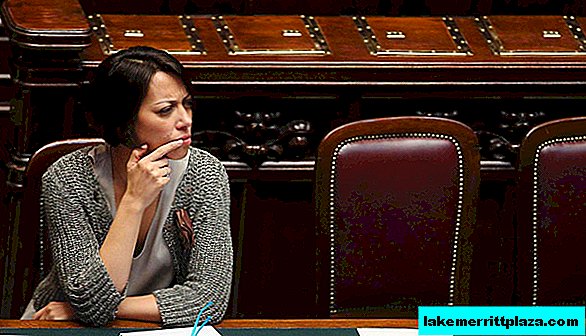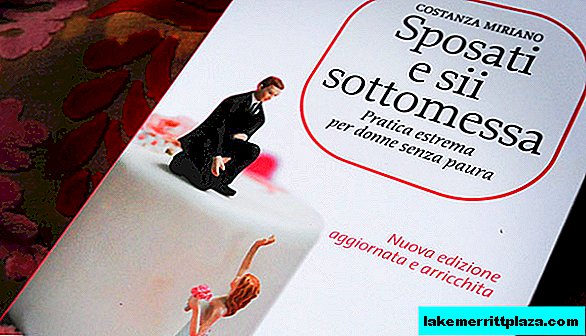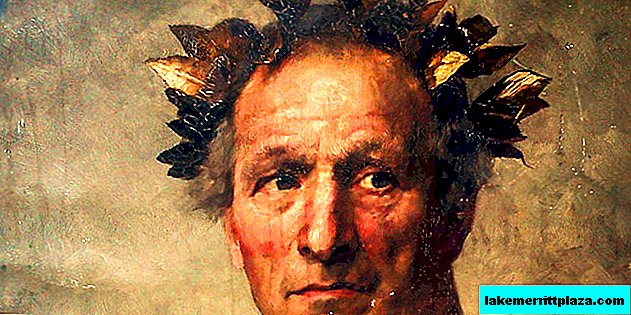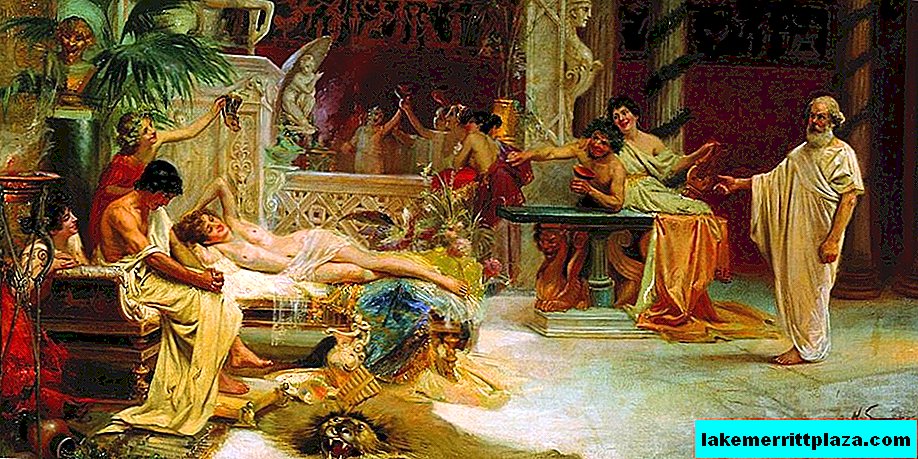The Vatican is the seat of the Holy See, the papal court and its attendants. Going there just like that “on a visit” will not work, but you can visit individual attractions. What tourist sites can be seen in the Vatican?

St. Peter's Square
The Vatican is the smallest state in the world, a dwarf enclave state. You can’t go there just like that, “on a visit”, but here you can visit individual tourist sites. Each of them has its own order of visits. What sights can ordinary tourists see in the Vatican?
St. Peter's Square
St. Peter's Square (Piazza San Pietro - Piazza San Pietro) is the largest Roman square located at the western tip of the Holy City. On all sides, Piazza San Pietro is surrounded by a colonnade. A white line is drawn on the stone tile along the outer perimeter of the square. This is not just a markup, but the state border of the Vatican. The rest of the state is surrounded by a medieval high wall.
An impenetrable wall was built in the 16th century to protect a sovereign territory from external intrusions. The total length of the Vatican state border is three kilometers. You can easily go around it in an hour completely, although you are unlikely to get interesting impressions of such a trip, because the Vatican is surrounded by ordinary city houses of modern buildings. Entrance to Piazza San Pietro is free - it is blocked only during important public events.
It is best to walk to the square from the Castle of the Holy Angel on Via della Conciliazione (Reconciliation Street). Along the way, you will get an unforgettable impression of the grand facade of the cathedral, appearing before your eyes and, as you approach it, gradually going down. This visual effect is due to the fact that the main facade of the cathedral stands far ahead of the rest of the building.
About Piazza San Pietro →Egyptian obelisk
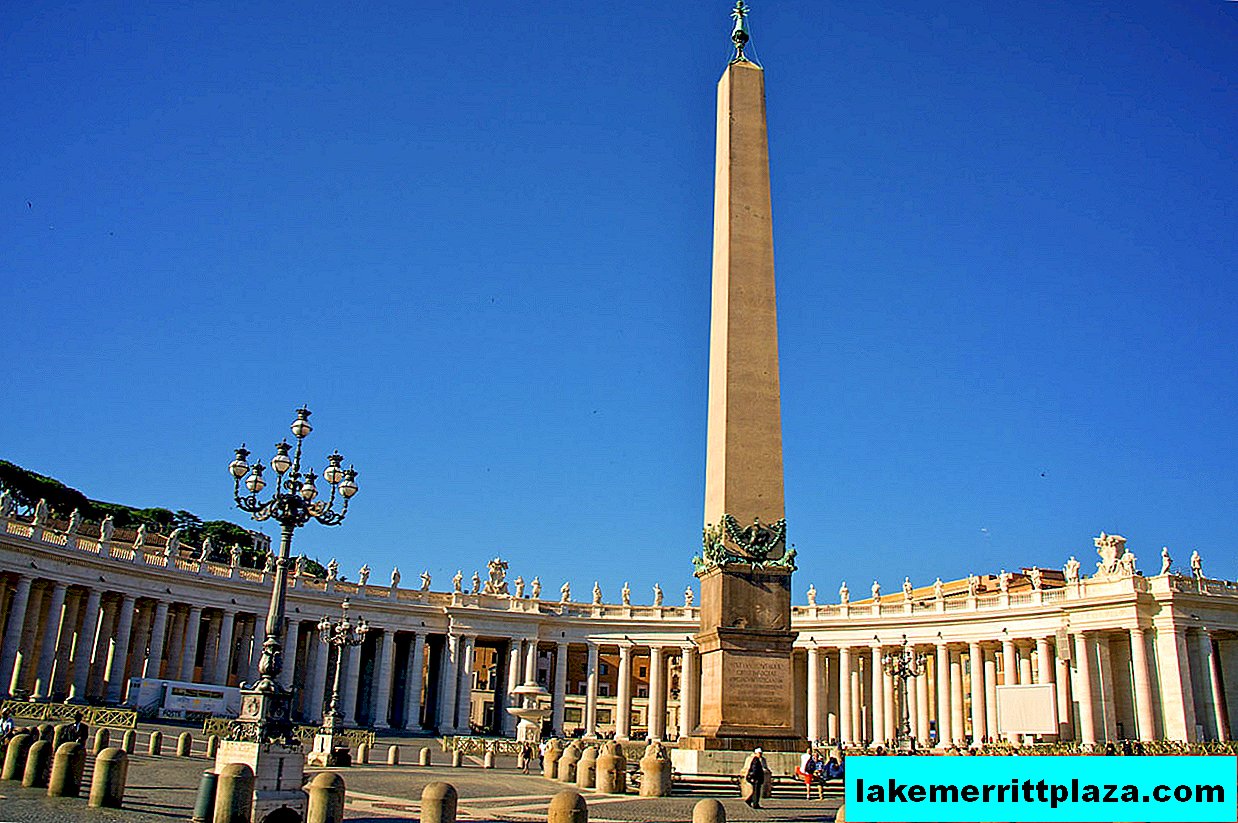
Bernini Colonnade and Egyptian Obelisk
In the center of Piazza San Pietro there is an Egyptian obelisk crowned with a bronze ball. This 35-meter colossus made of pink granite was brought to Rome by Emperor Caligula. In the square, the obelisk was installed under Pope Sixte V. It was transferred under the direction of the architect Domenico Fontana, in 1586. There is a legend that in the ball crowning the upper part of the obelisk, the remains of Caesar himself are kept.
Colonnade of Bernini

Colonnade of Bernini
Bernini's colonnade surrounds the square with two giant semicircles. The architectural ensemble of the square, formed by 284 Doric columns and the facade of the cathedral, resembles the outline of a key that opens the gates of paradise. Two points are marked on the square - two small circles of white marble. These points mark the centers of the circles formed by the colonnades. If you stand on one of these marble circles, then all four rows of columns will merge together. In this case, the observer will only see the first row of columns located at a considerable distance from each other.
Fountains in the square

Fountain in St. Peter's Square, photo attilio47
Three fountains are installed on the square. Two monumental baroque structures created by architects Bernini and Maderno stand at symmetrically located points on both sides of the obelisk. A small elegant drinking fountain "Tiara" (1852) is installed behind the right colonnade.
Apostolic Palace
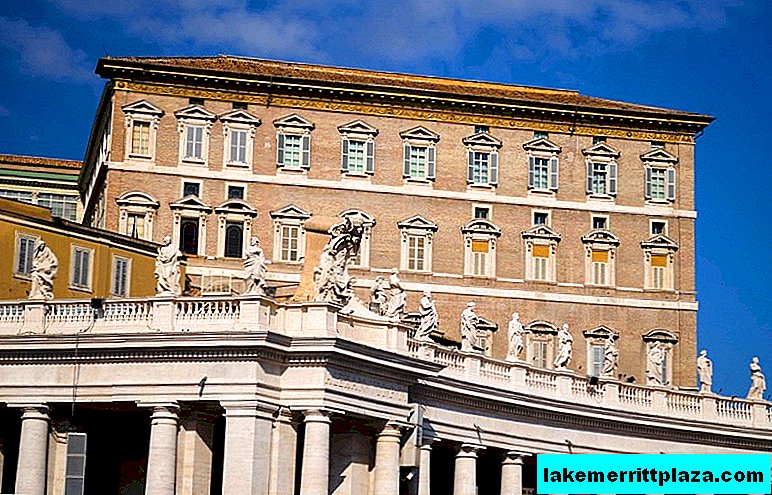
Papal Palace, photo by Manuel Marella
The Apostolic or Papal Palace (Palazzo Apostolico) is a complex of buildings that is located behind the right colonnade of the square. The architecture of this palace cannot be called harmonious and orderly. Over the centuries, on the orders of every pontiff, new rooms and buildings were attached to the palace. Now this architectural ensemble is an irregular quadrangle, consisting of many palaces and halls, galleries and gardens. On the top floor of the first from the area of the building is the office of the pope. From the second window to the right, the pontiff personally blesses and crosses the cross of believers who come to the square on Sundays.
The Sistine Chapel
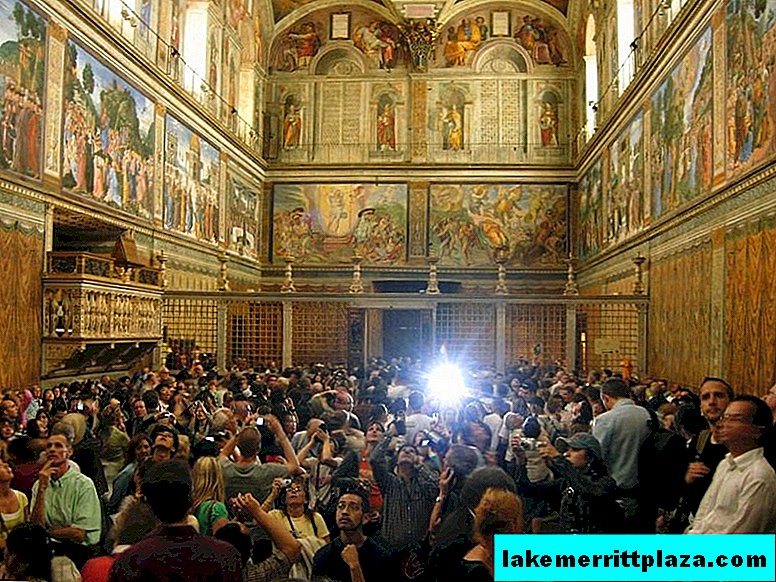
Sistine Chapel (Cappella Sistina), photo by xiquinhosilva
The modest building of the Sistine Chapel (Cappella Sistina), built in the 15th century by the architect Dolci, is located between the cathedral and the Apostolic Palace. Behind the chapel's ascetic facade, reminiscent of a defensive fortress with loopholes, there are hidden bewitching masterpieces of painting created by Botticelli, Perugino and Pinturicchio. The grand ceiling of the building is fully painted with frescoes by Michelangelo. The Sistine Chapel is called the spiritual treasure of the Vatican, the "precious box", a miracle of the Renaissance.
Read more about the Sistine Chapel →Swiss Guard

Swiss Guard, photo nobbiwan
The Vatican Swiss guards (Guardia svizzera pontificia) in the brightest striped full dress are at four points in the square. These unflappable soldiers guarding the peace of the Pope can be seen near the Bronze Gate at the entrance to the cathedral and near the exit from the basilica in the left corner of the square; near the papal Auditorium; at the gates of St. Anne (Cancello di Sant'Anna).
Vatican Post
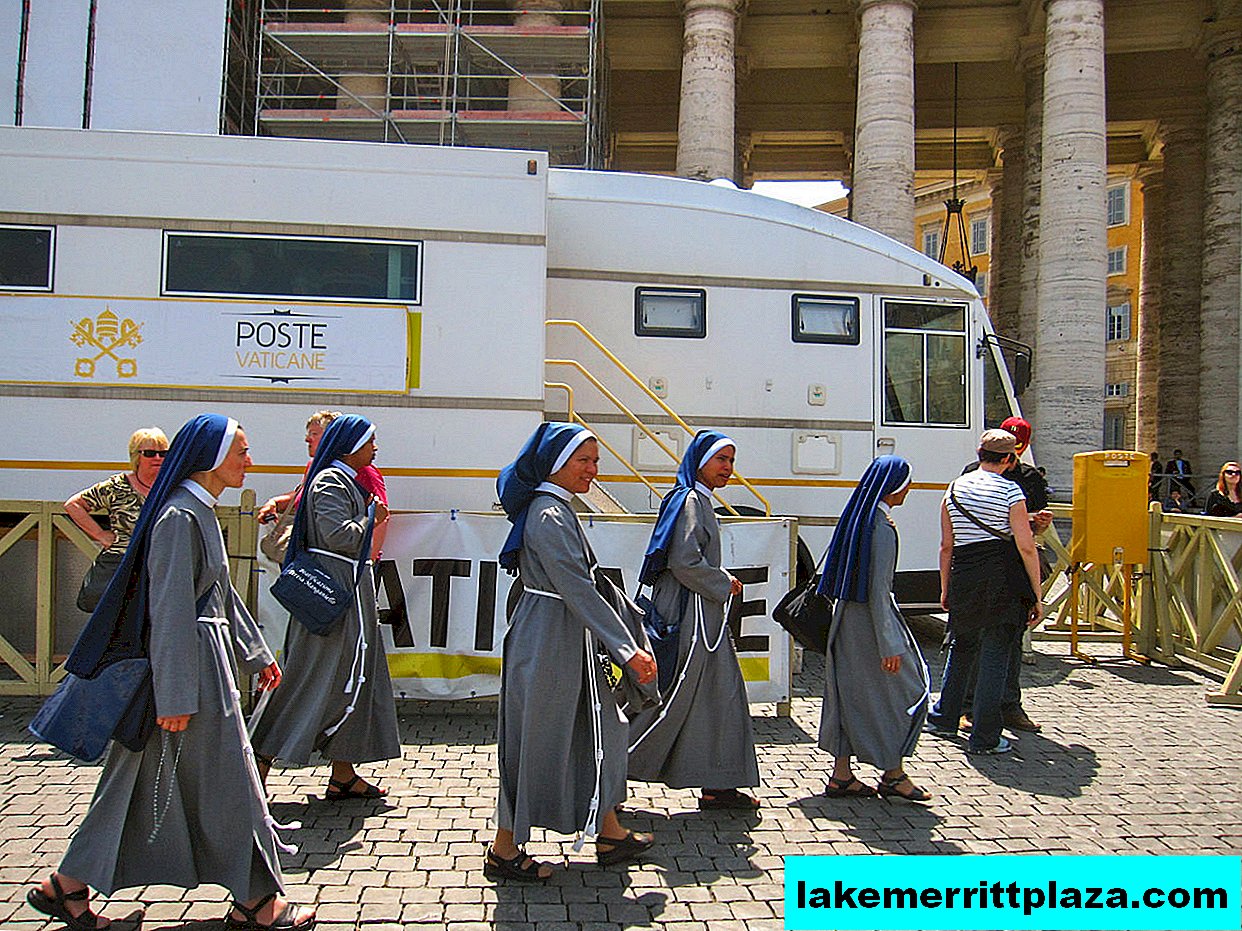
Vatican Post Office Mobile Office in San Pietro Square, photo by katie g *
The small building of the Vatican Post (Poste vaticane) is located in the left corner of Piazza San Pietro. If you decide to send home a postcard with a unique Vatican stamp, be sure to do it before you leave the territory of the state - because the Vatican's postage stamps in Italy are invalid. Colorful Vatican stamps and collectible coins can be purchased at the post office.
Behind the colonnade you can see the small Lamborghini police cars. On such cars, the Vatican is guarded by local law enforcement officers!
Saint Paul's Cathedral

I am at the Basilica of St. Petra
St. Peter's Basilica (Basilica Sancti Petri) is the main attraction of tourists in the Vatican, the second most important and most visited tourist attraction in Rome. The entrance to the basilica is open from 7 to 19 (in the winter until 18:30). In the days of papal audiences on Wednesdays, St. Peter's Square is closed for tourists, and then you can get to the basilica only at one in the afternoon.
Going to the cathedral is not easy. It is always crowded here, in front of the entrance you have to withstand a considerable queue for metal detectors. At the main entrance, which is located near the Bronze Gate, you can turn to the Swiss guards for a ticket to the papal audience. There is a left-luggage office on the right side of the entrance. There you can determine large things during the tour. Baby carriages are deposited without fail. Next to the camera you will see a pointer to the dome.
For a detailed inspection of the cathedral, including a visit to the Treasury, grottoes and the ascent to the dome, you will need at least three hours. You can enter the temple and quickly examine its decoration in about twenty minutes.
Basilica Treasury
Those who are not indifferent to jewelry and religious relics are advised to visit the treasury of the Sancti Petri Cathedral. This storehouse of values contains papal tiaras and elaborately decorated reliquaries; here you can see the famous relief tombstone of Pope Sixtus IV, the work of Antonio del Pollayolo. You can go to the treasury through the left nave of the cathedral. Paid entrance.
Cathedral Interior

Interior decoration
It is impossible to see the entire interior of the cathedral in one visit - the interior of the temple is blocked by barriers, for tourists usually only side naves and rear territory are left. In the far part of the main nave is the department of St. Petra, created by Bernini, and to the right of her is a monument to Clement XIII, made by Antonio Canova. You will be lucky if you manage to approach these sights of the cathedral at a close distance.
Above the tomb of St. Petra houses the Papal Altar with a 30-meter canopy by Bernini, surrounded by 95 lamps. These unquenchable lamps illuminate the descent to the tomb of the apostle. Ordinary tourists are not allowed to go down to the sacred tomb.
You can photograph the decoration of the cathedral. To navigate inside the huge temple, grab a good guide with a detailed description of its altars, chapels and tombstones.
Vatican Grottoes
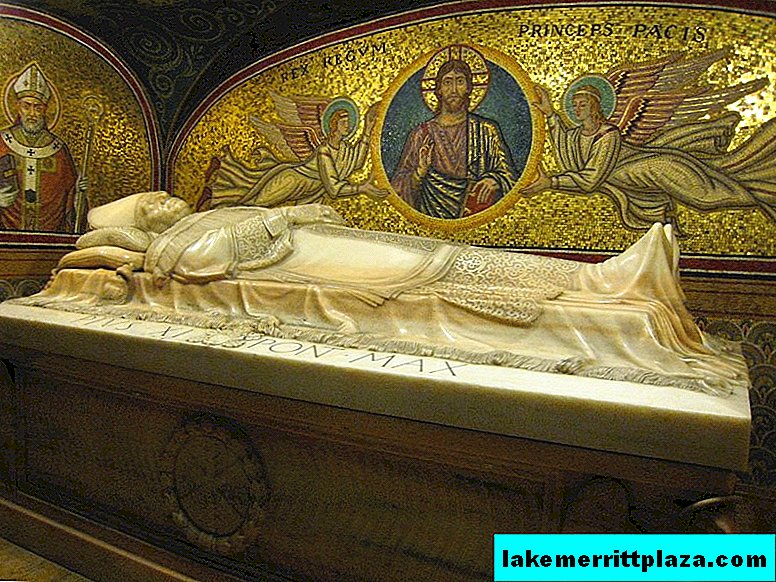
Papal Tomb, photo C K Leung
The lower level of the basilica is called the Vatican Grottoes. You can go there by going down from the transept. In the grottoes are papal tombs (the list of pontiffs resting in the cathedral is knocked out on a marble slab installed in front of the entrance to the treasury). The relics of emperors Otto II and Adrian IV are buried in underground mausoleums; the remains of the Swedish Queen Christina, King James III; the dust of many other noble persons. Here is the Capella delta Confessione - the chapel where St. Peter confessed. Entrance to the underground grottoes (Grotte Vaticane) is free.
Dome of the Cathedral
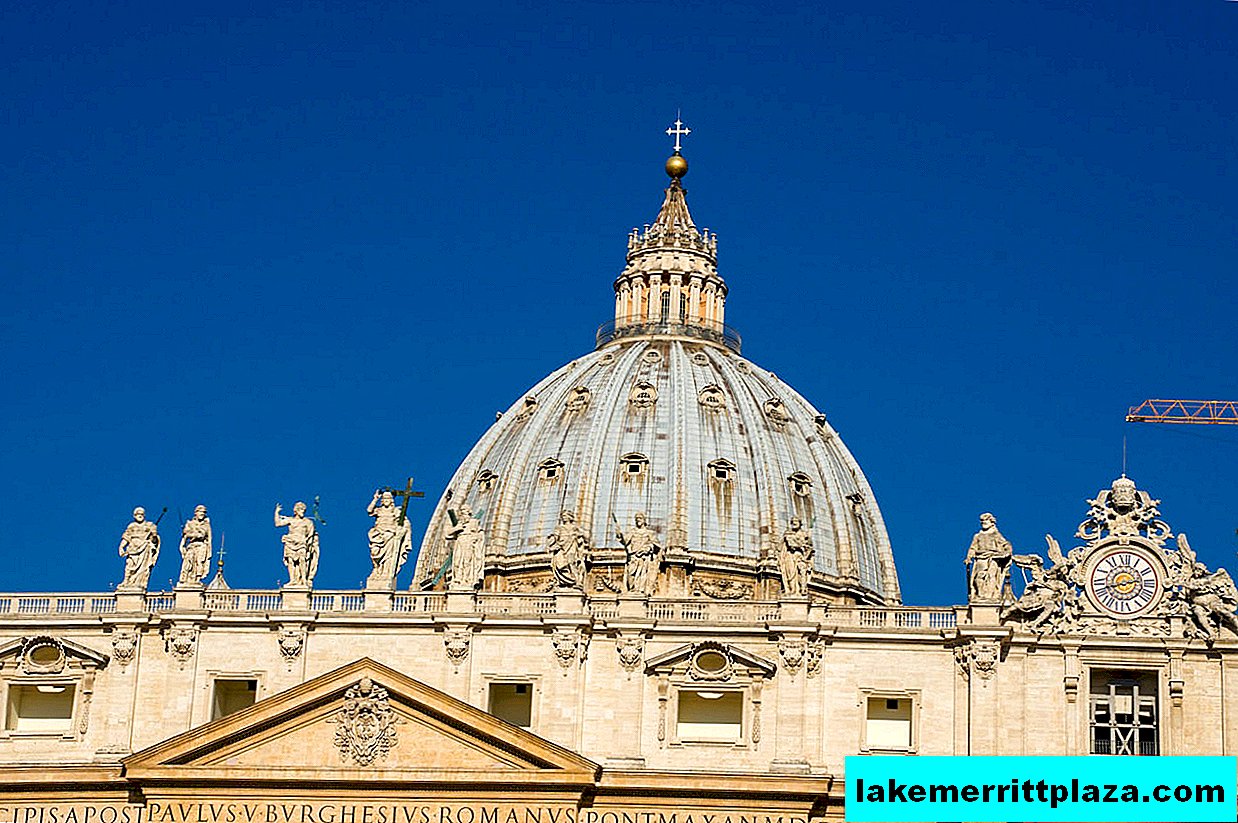
Dome of the Cathedral
Tourists climb to the dome of the basilica from the street, following the sign. There is always a queue for this climb. For 8 €, you can walk on a high staircase, and for 10 € you can take a special elevator to the middle of the path. This is the highest dome of the world - its height is 136.5 meters. The first stop on the steep route is the balustrade inside the cathedral. It is located above the golden inscription that runs around the circumference of the inner part of the dome.
Tourists move along the mosaic wall. A fine-meshed mesh separates the depths from the deep fifty-meter-long abyss, through which the pulpit and floor mosaic of the main nave are visible. Only from such a great height can you truly appreciate the beauty of the mosaic composition. Very close to those walking is the oval dome of Michelangelo. From here you can consider the details of his painting.
The second stop on the way is the roof of the cathedral. Huge statues are installed on the outer edge - you can come close to them. Here, right on the roof, there is another post office and a coffee shop.
The third, last stop on the way is the top of the dome. On a narrow staircase, laid between the outer and inner shells of a spherical structure, the most resistant travelers go to the observation deck near the window-laterna. The most impressive panorama of Rome is revealed from this observation deck.
Read about St. Peter's Basilica →Vatican Museums

Vatican Museums (Musei Vaticani), photo by Gé N.
Which museums are listed on the Vatican Museums
Vatican Museums:
- Gregorian Etruscan Museum
- Vatican Library
- Pio Cristiano Museum
- Vatican Pinacoteca
- Chiaramonti Museum
- History Museum (Vatican City)
- Collection of modern church art
- Ethnological Missionary Museum
Museums in the Papal Palace:
- Apartments Borgia
- The Sistine Chapel
- Chapel of Niccolina
- Raphael's stanzas
- Map Gallery
- Candelabra Gallery
- Gallery Arazzi
- Loggia of Cardinal Bibien
- Chariot Hall
Museums in the palace of Nicholas III
Innocent Palace VII:
- Museum of Pius Clement
- Gregorian Egyptian Museum
- Chiaroskuri Hall
- Loggias of Raphael
- Borgia Tower
- Palace of Nicholas V
- Loggias of the courtyard of San Damaso
- Chapel of Urban VIII
- Dam Hall
- Hall of the Virgin
- Papal Apartments
- House of St. Martha
- Sobieski Hall
- Immacolate Hall
This museum complex is called the "museums" in the plural, because it contains a lot of expositions, different in content and orientation. Tourists most often visit the Sistine Chapel, the Pio Clementino Sculpture Museum and Rafael Stanza. If you have enough time and energy, you can gradually go around all the local museums, but you can’t overcome such an intense program in one day.
Tourists are offered four routes through the Vatican Museums (Musei Vaticani), and a visit to the Sistine Chapel is included in each of them. If you have a little time and you want to see only the chapel, you need to follow the signs of Cappella Sistina. The road from the entrance to the Vatican to this attraction will take you about twenty minutes. However, you cannot buy a ticket only for visiting the chapel - its visit is included in the general route for exploring the Vatican museums. Tourists should know: there are two exits from the Sistine Chapel. The exit to the left leads further along the "museum" route; to the right you can go directly to the Cathedral of St. Petra, bypassing the line.
Throughout the Vatican Museums you can take pictures, only without a flash. In the Sistine Chapel, it is strictly forbidden to use the camera and even speak loudly - it is believed that this can damage the precious frescoes.
All information about the Vatican Museums and a detailed list of all exhibits are presented on the official website.
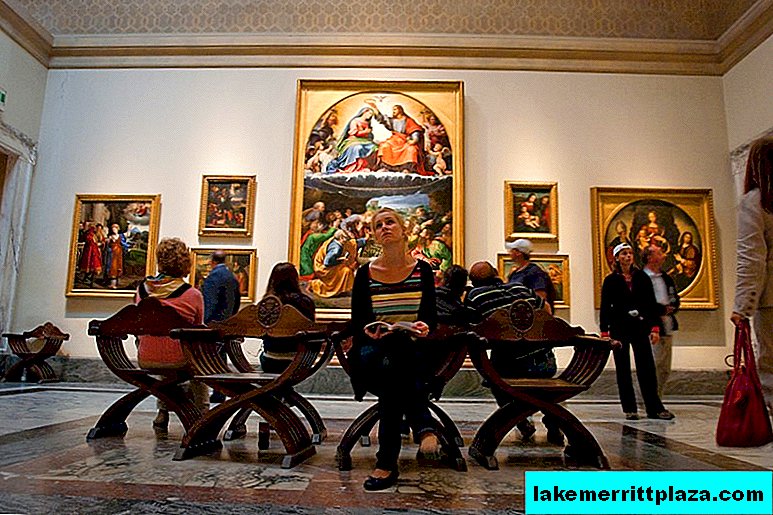
At the Vatican Museum, photo by Marcus Winter
How to get to the Vatican Museums
You can get to the museums from the Ottaviano metro or from Piazza San Pietro - towards Piazza Risorgimento. There is a long line along the Vaticano to museums. If you booked a ticket in advance, you don’t have to stand in it, and then it will be more convenient to get to the museums from the Cipro metro station.
Vatican Museums Free
You can visit the Vatican Museums for free. This opportunity is given to tourists every last Sunday of the month. The queue must be taken at half past seven in the morning and tune in to a long wait. Visitors are not allowed in too large groups, you can stand for about two hours. Entrance is open until 12:30, and museums are open until 14:00.
You can also visit the Vatican Museums for free on International Tourism Day (September 27th).
Tickets
On ordinary days, there are also long lines, however, you can save time if you buy tickets online (but for booking on the Internet you will have to pay 4 €). Ticket price - 17 € (Vatican Museums and the Sistine Chapel), audio guide 7 €. The voucher that will come after the reservation to your e-mail must be printed out to be presented at the entrance to the museum. After that, you will pass without waiting in line.
Recently, tourists have a convenient opportunity to visit the main parts of the Vatican Museums in the evenings - on Fridays, from 19 to 23:00. Entrance is only possible with pre-booked tickets.
A trip to museums usually takes at least three hours. A self-service dining room is open for tourists, but it is only the most hungry to go there. The food in the Vatican canteen is too expensive and tasteless. For example, a plate of regular french fries there costs 4.5 €.
About the Vatican Museums →Vatican Gardens
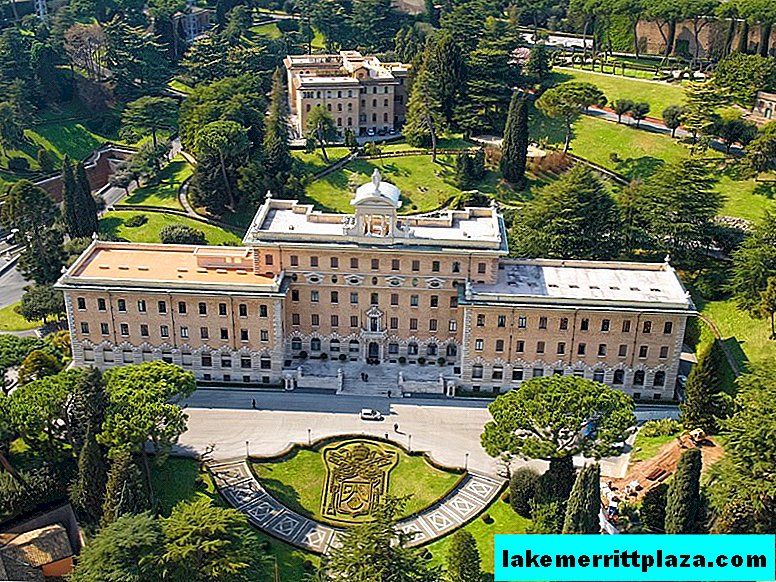
Vatican Gardens (Giardini Vaticani), photo by Einsiedler
Tour booking
Access to the Vatican Gardens is possible only by prior reservation (2 months before the visit). The price of the visit is 33 €. The price includes a guided tour of the gardens (you must specify the audio language in advance - you can choose Russian) plus a visit to the Vatican Museums and the Sistine Chapel. After paying for the reservation on the official website, an email with the code of your reservation will be sent to the email address, and in the attached PDF file there will be a voucher for visiting the museums, which you need to print.

Vatican Station, photo R4all
What you will see in the Vatican Gardens
The duration of the tour of the Gardens is two hours. Tourists are shown the cottage of Pope Pius IV - Villa Casina, small and picturesque, built on the example of ancient Roman villas. Visitors see numerous stone benches and sculptures, ancient towers (Vetrov, John, Gallinara) and moss-covered stairs, old Vatican walls, a radio tower, helipad and a quiet deserted Vatican station. The most impressive of the local fountains is the Galleon Fountain (XVII century). It is a small copy of the ship - the Italian galleon, shooting water from sixteen guns.
French, Italian, English kindergartens impress with their unique style and extraordinary, impeccable grooming - as befits true paradise cabbage.Twenty gardeners take care of the green spaces. Near each plant in this outlandish garden of paradise you can see a tablet with its name.
Animals live here freely: squirrels and rabbits, bats, foxes and hamsters, lizards and snakes. Flocks of restless green parrots flutter along the branches. They say that these birds once flew from the cages of merchants and found shelter in the Vatican gardens.
Among the green thickets you will see different buildings: the grand Palazzo Governatorato - the palace of the Vatican government; Ethiopian College - an educational institution for the training of Catholic missionaries in African countries; ancient abyssinian temple of st. Stefan. The Sistine Chapel is viewed from the back. Views of the dome of the Cathedral of St. Petra's open here from everywhere.

In the Vatican Gardens, photo R4all
The Vatican gardens are vast, but do not be afraid to get lost among the trees. Guides and representatives of the gendarmerie closely monitor the movements of tourists. You will not meet the inhabitants of the Vatican, and even more so, the Pope himself.
A tour of the Gardens ends in the lobby of the Vatican Museums - members of the group can start an independent tour of the exhibits from there.
You can go to museums only on the day of the tour of the Gardens - the next day, unfortunately, tickets are not valid. If you visit the Vatican Gardens on the day of booking, for some reason you can’t get it - you can postpone the date of the tour. How to do this is indicated on the site.
Necropolises of the Vatican

Necropoli Vaticana, photo by Samantha Lombardi
Under the St. Peter's Basilica lies the foundation of an ancient basilica built in the era of Emperor Constantine. When archaeological excavations were carried out here in the first half of the 20th century, extensive dungeons were discovered under the old foundation. These were the Vatican necropolises - multiple burials of the I-IV centuries, concentrated around a large and, by all accounts, very important tomb for Christians.
If the Vatican Grottoes provide free entrance for tourists, then you can’t just go to the necropolis. These dungeons are the holy of holies of the Christian religion. Given their extraordinary importance and significance, a visit to the facility is strictly regulated.
Booking excursions to the necropolis
Excursions to the necropolis (Necropoli Vaticana) must be booked in advance. Surnames, desired date of visit, language of excursion should be indicated (Russian-speaking accompaniment is not offered here). When after checking your details the visit time will be set, within 3 days you need to send a confirmation of participation and pay. The cost of this tour is € 27 (Necropolis + Vatican Museums and the Sistine Chapel). If tourists refuse to visit the Necropolis, the amount paid will not be refunded. Further instructions to future members of the group are sent by email after payment
Recommendations for visiting the necropolis
On an excursion to the Vatican necropolis, children under 13 years old are allowed only accompanied by their elders. Groups of ten to twelve people are formed. Dress code - as when visiting the cathedral, and throughout the Vatican - closed. Bare shoulders, open shorts, short skirts are unacceptable. However, for excursions to the dungeons, even in the summer, you should dress warmer.
The gathering of formed groups of excursions takes place at Piazza San Pietro. You need to come fifteen minutes before the start and do not forget the printout of the reservation. With this paper, you need to contact the guardsmen, standing in the far left corner of the square under the clock, near the exit from the basilica. Law enforcement officers will appreciate the correspondence between the appearance of the excursionists and the Vatican "dress code" and let the audience pass under the arch.
Go to the Skavy office between metal fences. To the left of the road is Teutonic College with an adjacent cemetery located in a small palm garden. These burials have existed since the VIII century. Behind the Teutonic Cemetery is the San Pietro Factory; followed by the Treasury. Next you will see the Ufficio Scavi office. There you will again present your printout, change it to a ticket and wait for the guide.
Necropolis Tour
The journey through the dungeon begins with a large hall in which ancient sarcophagi are installed. It is followed by the entrance to the necropolis. If you have already visited the Roman catacombs, here you will see a certain resemblance to them. However, there are significant differences in the structure of these dungeons. The catacombs were originally laid underground, and the Vatican necropolises were an open cemetery - a church foundation appeared above them later.
They will tell you about the graves. You will see fragments of the walls of the ancient basilica built under Constantine, the family crypt of the Roman aristocratic family, richly decorated with paintings and mosaics. Gradually, you will come closer to the "heart" of the necropolis - the legendary tomb found during excavations of 1939. On this tomb was found the inscription "Peter is here" - "Petros eni".
The tomb of the apostle is located directly under the main altar of the cathedral. Scientists to this day do not agree - do St. Peter really lie in the tomb, marked with an inscription? The probability is very high, however, reliable conclusive evidence was not found.
There is no answer to the main question of scientists: why was the burial so long hidden from people. There is a version that in this way the emperor Constantine sought to hide the tomb of the apostle from ruin. He hid the tomb with a huge basilica, marking a sacred burial place inside the temple.
A tour of the Necropolis ends in the Vatican Grottoes. Tourists can already inspect these dungeons on their own. In order to go back to the cathedral, when leaving the arch you need to turn left and climb up the steps of the portico.
Photography in the necropolis is strictly prohibited. As a kind of compensation for tourists, the Vatican website offers a video with details of this tour.
Visit the tomb of St. Petra and Necropolis are also available for 13 €. Full information on organizing excursions here.
Lateran Palace

Lateran Palace (Palazzo del Laterano), photo by Dan
The Lateran Palace is located next to the Basilica of San Giovanni in Laterano. In the pre-existing palace, which was the forerunner of modern Lateran, the popes lived through the 16th century, up until the moment of resettlement to the Vatican. The palace that we see now was built later - in 1589, at the insistence of Sixtus V. The building belongs to the Vatican City. Today it houses the apartments of the chief vicar of Rome, the offices of the Roman diocese, various bureaucratic services and the History Museum.
Lateran Palace is visited by tourists. You can enter the building to the right of the portico of the main facade of the basilica. Guided tours of the palace are held daily, except holidays and Sundays - four times a day, every hour, starting from 9 a.m.
Tourists visiting the interior interiors with rich ceiling paintings, ancient mosaics. Guides present to tourists items of the Vatican ceremonial and talk about its traditions; demonstrate the most important historical documents, uniforms and weapons of the Vatican Guard.
A visit to the Lateran Palace is now possible only by prior reservation, in groups of at least thirty participants.
The audience of the pope
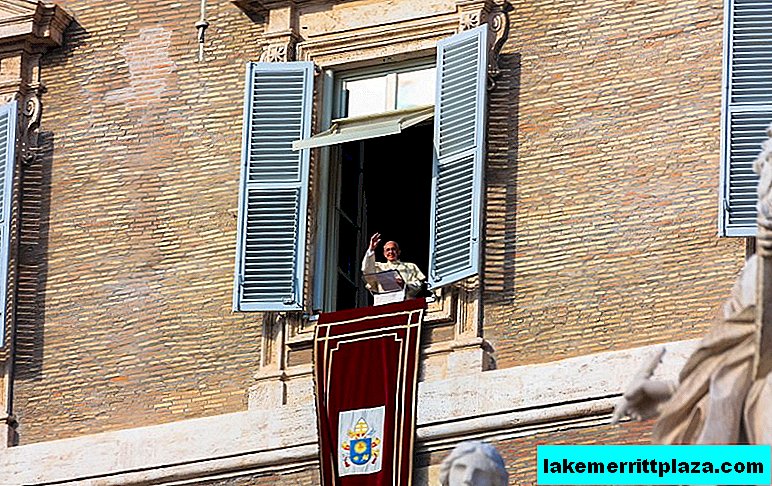
Pope blesses believers, photo by Gaetano Castaldo
On Wednesdays, in the morning, on the days of his stay at the residence, the Pope turns to numerous pilgrims. He goes to the assembled believers and personally blesses them. In warm times, this event takes place at Piazza San Pietro, and in winter or on rainy days, the ritual is held in the Auditorium, in a white modern building with a fancifully curved roof, built to the left of the basilica. In July-August, general audience ceremonies are transferred to the town of Castelgandolfo, the summer residence of the Pope. The schedule of the order of audiences is presented on the state website.
The ceremony begins at half past ten in the morning. As early as 9 a.m., pilgrims gather at the colonnade: nuns, organized groups of different parishes, associations and religious schools, ordinary tourists. The crowd worries in anticipation of the Pope, and the guards have great difficulty restraining her.
The papal audience is an unforgettable event even for people who do not profess the Catholic religion. Tickets for this event are issued by the Prefecture of the Papal House.
When visiting the Vatican, remember that a single Roma Pass ticket is not valid on its territory. There is no passport control on the border of the Vatican and Italy.
How do I save on hotels?
Everything is very simple - look not only at the booking. I prefer the search engine RoomGuru. He is looking for discounts at the same time on Booking and on 70 other booking sites.

